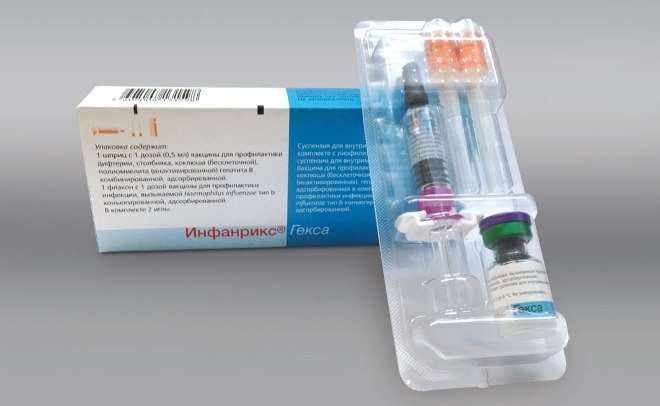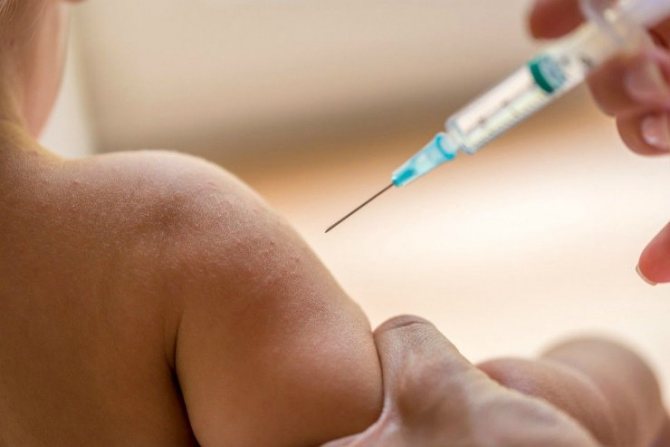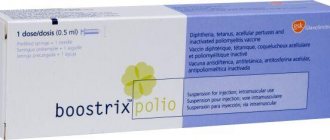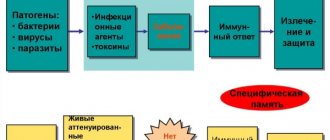Compound
The British company GlaxoSmithKline produces the vaccine at Belgian pharmaceutical plants. European quality standards guarantee a normal composition that does not cause complications. At the moment, all doctors recommend vaccinating a child with this.
The composition includes an toxoid that promotes the production of antibodies to a specific toxin. The active substances are toxoids:
- whooping cough;
- tetanus;
- diphtheria;
- hepatitis B antigen;
- Hib component;
- deactivated polio virus types 1, 2, 3;
- filamentous hemagglutinin;
- shell of the Haemophilus influenzae bacterium.
What is the Infanrix Hexa vaccine for? Composition and release form
The Infanrix vaccine is a complex vaccine preparation that was developed to protect children and adults from several serious diseases. Its variety Hexa (Infanrix Hexa) forms immunity against diphtheria, tetanus and whooping cough, as well as polio, hepatitis B and Haemophilus influenzae infections.
The drug was developed in England by the GlaxoSmithKline concern (where many vaccinations and other medications are invented and mass-produced). The company is one of the leaders in the pharmaceutical industry (in various ratings it ranks third in terms of geographical coverage of market segments), owns branches and representative offices all over the world, including in Russia. This is a joint venture of SmithKline Beecham - Biomed LLC. True, Infanrix is not manufactured at a domestic plant. The production of the described vaccine is carried out by Belgium.

The main difference between Infanrix and DTP is that it does not include whole pertussis cells, which, after the domestic vaccine, cause the most trouble. It is purified and better tolerated. However, some experts are of the opinion that DTP is more effective and contributes to the formation of more stable immunity. But this has not been proven clinically.
The Infanrix Hexa vaccine has the following composition:
- diphtheria toxoid – 30 IU;
- tetanus toxoid – 40 IU;
- pertussis bacillus toxins – 25 mcg;
- pertactin;
- hepatitis B antigen – 10 mcg;
- inactive viruses of three types of polio - 40 units of antigen of the first type, 8 units of the second, 31 units of the third;
- capsular polysaccharide of Haemophilus influenzae. The Hib component is included in the formula based on tetanus toxoid.
Pertussis bacteria are not whole cells, they are destroyed, and only those components that are important for the development of immunity are isolated from them. Hemagglutinin and pertactin are also pertussis antigens. The toxoids of the other two diseases are neutralized through high temperatures and purified.
Auxiliary elements, including preservatives - aluminum compounds, nutrient media used for growing antigenic material, as well as sodium chloride. Controversial formaldehyde and mercury-containing merthiolate are absent in the drug formula. The hemophilic component includes antibacterial substances (polymyxin and neomycin), which is taken into account in case of allergies to these agents.
In addition to Infanrix Hexa, there is also Infanrix and Infanrix IPV. These vaccines have been used since 1994. The main difference is the number of active ingredients.
The whole difference between Infanrix and Infanrix Hexa becomes clear from the names. Hexa means “six” in Latin, which means the vaccine protects against six diseases. In regular Infanrix there are only three components, as in DPT. The IPV vaccine means that it contains neutralized polio viruses. If Tetra appears after the name, it means a remedy for four diseases.
The product is available in the form of a whitish suspension. When the contents of the ampoule settle, a clear solution and a white precipitate are clearly visible. The blister pack contains a single dose of the drug in a disposable syringe - this is 5 milliliters. The needle is also included in the kit. This packaging ensures that the material remains sterile. There are blisters with ten doses.
pharmachologic effect
Vaccination with this drug is a paid service, but it is significantly superior in quality and effect to the others provided in the course of free mandatory injections.
It contains a minimum of amino acids that weaken the central nervous system, so children with weak immune systems may also be susceptible to the effects of Infanrix Hexa. It cannot be said that once the drug is administered, viruses and infections will never enter the body again. One way or another, the disease will be mild if you do catch it.
A special production technology protects against complications and side effects. Allergic reactions are practically impossible. Occasionally, illness due to the Hib component appears, but individual intolerance should be known in advance.
It is used both as primary immunization and after the administration of other medications as a revaccination. It is important that you need to allocate time to visit the clinic according to a specific schedule.
What does Infanrix Hexa protect against?
Above we have already listed the diseases against which Infanrix Hexa helps to develop immunity. These are whooping cough, diphtheria, tetanus, hemophilus influenzae, polio and hepatitis B. Many critically thinking parents have a question: what kind of diseases are these and is it necessary to vaccinate a child under the age of one year against them? After all, any vaccine, whatever one may say, creates a certain load on the body?
This is not done in vain. All diseases against which vaccination is carried out in the first year of life are especially dangerous for infants and most often end in death in this age group. Below we provide information about the dangers of each of the listed diseases.
Whooping cough is a highly contagious bacterial infection that causes the maximum number of complications in children under one year of age. The disease manifests itself as a long, painful cough that cannot be stopped by any means. This cough usually lasts longer than a week, and complications include pneumonia, pleurisy, epilepsy, and even cerebral hemorrhage. Deaths have been recorded. An increasing incidence of whooping cough is recorded in Moscow every year.
There are cases where vaccinated children did get whooping cough, but in this case the disease was mild and did not cause dangerous complications.
Diphtheria in children , as a rule, occurs in the form of oropharyngeal diphtheria. This is dangerous in itself, as it is often accompanied by swelling, which can cause suffocation. But besides this, diphtheria is extremely dangerous due to complications that almost always accompany the underlying disease - damage to the nervous system, brain, and especially often to the heart.
Tetanus is a disease with a very high fatality rate. Normally, tetanus spores surround us everywhere and are not capable of harming us. However, when they get into an open wound, they cause a terrible disease. And it is small children who are most traumatic - they often fall, get abrasions, scratches, get splinters and pricks from plant thorns. It is very difficult to treat tetanus, and it is extremely painful for the patient, with constant convulsions, and is accompanied by severe complications.
Haemophilus influenzae infection is caused by Haemophilus influenzae, which belongs to the opportunistic flora and, in principle, is present in most people without causing any diseases. However, for a weakened body, hemophilus influenzae can be fatal. It is no coincidence that hemophilus influenzae infection often occurs during treatment with strong antibiotics for some other disease. At the same time, the widespread use of antibiotics provokes the emergence of increasingly resistant forms of Haemophilus influenzae infection, which are very difficult to treat. It manifests itself in different ways: most often - pneumonia and other diseases of the respiratory tract, but meningitis, arthritis, pericarditis, and damage to the nervous system as a manifestation of hemophilus influenzae infection also occur. It is especially difficult for small children.
Poliomyelitis is not often fatal and is sometimes completely asymptomatic. This is where its danger lies: its spread cannot be limited through quarantine, since it is not always possible to diagnose it. At the same time, it is transmitted very easily and often results in paralysis as a complication. Poliomyelitis poses the greatest danger to children aged one to five.
Hepatitis B affects the liver. Having contracted it in childhood, a person, even after recovering from the disease, remains a carrier of hepatitis B for life. In about a third of cases, the survivor develops cirrhosis or liver cancer. At the same time, it is very easy to become infected with hepatitis B - it is transmitted even through household means, for example, through shared towels, and is resistant to boiling for several minutes. In infants under the age of one year, hepatitis B, as a rule, occurs in severe or moderate form.
Indications for use
Since Infarix Hexa should not be given as a treatment but as a preventive measure, it is usually administered following the vaccination schedule in the Russian Federation. The pathogen is introduced at 3, 4.5 and 6 months, i.e. 45 days after each injection. You can vaccinate again one year after completing the course.
In individual cases, the doctor can recommend excellent schedules for immunization procedures:
- Every 30 days from two to four months of life.
- With a break of 60 days between injections.
- At 3, 4 and 5 months.
If a kindergarten or school is referred for the introduction of a needle, then it is better to get the Infanrix Hexa vaccine at 6 years of age.
Characteristic:Composition of suspension for intramuscular administration of Infanrix Hexa 1 dose (0.5 ml): - adsorbed diphtheria toxoid not less than 30 International Units (IU) - adsorbed tetanus toxoid not less than 40 IU - adsorbed pertussis toxoid (PERT) 25 mcg - adsorbed filamentous hemagglutinin (FHA) — adsorbed pertactin 8 μg — adsorbed recombinant HBsAg 10 μg — D-inactivated polio virus type 1 antigen (Mahoney) 40 units — D-inactivated polio virus type 2 antigen (MEF-1) 8 units — D-inactivated antigen polio virus type 3 (Saukett) 32 units - adsorbed purified capsular polysaccharide of Haemophilus influenzae type b, covalently associated with 20-40 mcg of tetanus toxoid, 10 mcg excipients: lactose, aluminum hydroxide and aluminum phosphate (adsorbents), sodium chloride, water for injection, Medium 199, potassium chloride, sodium hydrogen phosphate, potassium dihydrogen phosphate, polysorbate 20 and 80, glycine, formaldehyde, neomycin sulfate, polymyxin B sulfate. Description: A whitish suspension that separates when standing into a colorless transparent liquid and a white precipitate that completely breaks up when shaken in a syringe. White powder or dense mass in a bottle. After dilution, a turbid liquid is formed, which, when slowly settling, gives a white precipitate. The sediment easily turns into a suspension when shaken.
Pharmgroup:
Vaccine for the prevention of diphtheria, tetanus, whooping cough, hepatitis B, polio and diseases caused by Haemophilus influenzae type b
Pharmaceutical action:
Vaccine against diphtheria, tetanus and whooping cough.
Infanrix® Hexa contains diphtheria toxoid, tetanus toxoid, three purified pertussis antigens [pertussis toxoid (PTA), filamentous hemagglutinin (FHA) and outer membrane protein (pertactin) with a molecular weight of 69 kDa], purified major surface antigen (HBsAg) of the hepatitis B virus and purified capsular polysaccharide of Haemophilus influenzae type b, covalently bound to tetanus toxoid, adsorbed on aluminum salts. The vaccine also contains three types of inactivated polioviruses (type 1 - Mahoney strain, type 2 - MEF-1 strain, type 3 - Saukett strain). Tetanus and diphtheria toxoids are produced by treating purified Corynebacterium diphtheriae and Clostridium tetani toxins with formaldehyde. Acellular pertussis vaccine components are obtained from Bordetella pertussis culture by extraction and purification, followed by detoxification with glutaraldehyde and formaldehyde of pertussis toxin, and formaldehyde of filamentous hemagglutinin and pertactin. Hepatitis B virus surface antigen is produced by a culture of yeast cells (Saccharomyces cerevisiae), obtained by genetic engineering and having a gene encoding the main surface antigen of the hepatitis B virus. HBsAg isolated from yeast cells is purified using sequentially applied physicochemical methods. HBsAg, in the absence of chemical treatment, spontaneously transforms into spherical particles with a diameter of 20 nm containing non-glycosylated HBsAg polypeptides and a lipid matrix consisting mainly of phospholipids. Studies have shown that these particles have properties characteristic of natural HBsAg. Three types of polioviruses grown on VERO cells are purified and inactivated with formaldehyde. Hib polysaccharide is prepared from Haemophilus influenzae type b strain 20.752. After activation with cyanogen bromide and derivatization with adipic acid hydrazide, it is combined with tetanus toxoid by the carbodiimide method. After purification and conjugation, the polysaccharide is adsorbed onto aluminum salts, then lyophilized in the presence of lactose as a stabilizer. Infanrix® Hexa meets WHO requirements for the production of biological substances, diphtheria, tetanus, pertussis and combination vaccines, as well as recombinant hepatitis B vaccines, inactivated polio vaccines and Haemophilus influenzae type b conjugate vaccines. The results obtained in clinical studies for each vaccine component are presented in Tables 1 and 2. Table 1. Percentage of participants with antibody titres ≥ breakpoint 1 month after primary vaccination with Infanrix® Hexa vaccine. Antibodies (borderline level)
| 2 doses | 3 doses | ||||
| 3-5 months n= 530 (4 studies) | 2-3-4 months n= 196 (2 studies) | 2-4-6 months n= 1693 (6 studies) | 3-4-5 months n= 1055 (6 studies) | 6-10-14 weeks n= 265 (1 study) | |
| % | % | % | % | % | |
| Anti-diphther. (0.1 IU/ml) # | 98.0 | 100.0 | 99.8 | 99.7 | 99.2 |
| Anti-pillar (0.1 IU/ml)# | 100.0 | 100.0 | 100.0 | 100.0 | 99.6 |
| Anti-CT (5 EL.E/ml) | 99.5 | 100.0 | 100.0 | 99.8 | 99.6 |
| Anti-PHA (5 EL.U/ml) | 99.7 | 100.0 | 100.0 | 100.0 | 100.0 |
| Anti-PRN (5 EL.U/ml) | 99.0 | 100.0 | 100.0 | 99.7 | 98.9 |
| Anti-HBs (10 mIU/ml) # | 96.8 | 99.5 | 98.9 | 98.0 | 98.5* |
| Anti-polyotype 1 (1/8 dilution)# | 99.4 | 100.0 | 99.9 | 99.7 | 99.6 |
| Anti-polyotype 2 (1/8 dilution) # | 96.3 | 97.8 | 99.3 | 98.9 | 95.7 |
| Anti-polyotype 3 (1/8 dilution)# | 98.8 | 100.0 | 99.7 | 99.7 | 99.6 |
| Anti-PRP (0.15 µg/ml) # | 91.7 | 96.4 | 96.6 | 96.8 | 97.4 |
* - in the subgroup of children who did not receive the hepatitis B vaccine at birth, 77.7% of children had a titer of anti-HBs antibodies (≥10 mIU/ml). # — a borderline value indicates the presence of protection. EL.E - ELISA units (enzyme-linked immunosorbent assay, ELISA). PRP - polyribosyl rebitol phosphate. Table 2. Percentage of participants with antibody titres ≥ cutoff value 1 month after revaccination with Infanrix® Hexa vaccine.
| Antibodies (borderline value) | Revaccination at 11 months after primary vaccination at 3-5 months n = 532 (3 studies), % | Revaccination in the second year of life after three-dose primary vaccination n = 2009 (12 studies), % |
| Anti-diphther. (0.1 IU/ml)# | 100.0 | 99.9 |
| Anti-column (0.1 IU/ml)# | 100.0 | 99.9 |
| Anti-CT (5 EL.E/ml) | 100.0 | 99.9 |
| Anti-PHA (5 EL.U/ml) | 100.0 | 99.9 |
| Anti-PRN(5 EL.U/ml) | 99.2 | 99.5 |
| Anti-HBs(10 mIU/ml) # | 98.9 | 98.4 |
| Anti-poliotype1 (1/8 dilution)# | 99.8 | 99.9 |
| Anti-poliotype2 (1/8 dilution)# | 99.4 | 99.9 |
| Anti-poliotype3 (1/8 dilution)# | 99.2 | 99.9 |
| Anti-PRP (0.15 µg/ml)# | 99.6 | 99.7 |
# — a borderline value indicates the presence of protection. Since the immune response to pertussis antigens after administration of the Infanrix® Hexa vaccine is equivalent to that after the administration of the Infanrix® vaccine, the protective activity of both vaccines is equivalent. The protective effect of the pertussis component of the Infanrix® Hexa vaccine against typical pertussis (as defined by WHO) (≥ 21 days of paroxysmal cough) was proven in the following studies: - a prospective, blinded study involving household exposure to pertussis, conducted in Germany (vaccination schedule 3, 4 and 5 months). Based on data collected during follow-up contacts with families in which the first case of typical whooping cough was reported, the vaccine was found to be 88.7% protective. - National Institute of Health-sponsored study conducted in Italy (vaccination schedule 2, 4 and 6 months). The vaccine was found to be 84% effective. Follow-up in the same cohort found that demonstrated efficacy was maintained for up to 60 months after completion of primary vaccination, without an additional dose of pertussis vaccine. Long-term follow-up results from Sweden indicate that acellular pertussis vaccines are highly effective in children when given at 3 and 5 months of age, with a booster dose at approximately 12 months. The protective level of antibodies against hepatitis B after administration of Infanrix® Hexa did not differ from the level recorded in the parallel group receiving monovalent hepatitis B vaccine. The effectiveness of the Hib component (when administered simultaneously with DTPa, or DTPa-IPV or DTPa-HBV-IPV) was has been and continues to be studied in a large post-marketing observational study conducted in Germany. During the 4.5-year follow-up period, the effectiveness of DTPa/Hib or DTPa-IPV/Hib vaccines was 96.7% for primary vaccination and 98.5% for booster doses (regardless of primary immunization). During the three-year follow-up period, the efficacy of hexavalent vaccines was 92.8% for the completed primary series and 100% for the booster dose.
Indications:
- primary and additional vaccination of children against diphtheria, tetanus, whooping cough, hepatitis B, polio and meningitis caused by Haemophilus influenzae type b.
Category of effect on the fetus: Infanrix® Hexa is not intended for use in adults.
Contraindications: - hypersensitivity to the components of the drug; - hypersensitivity reaction to previous administration of vaccines against diphtheria, tetanus, whooping cough, hepatitis B or polio; — encephalopathy of unknown etiology within 7 days after the previous vaccination with the pertussis component. In this case, pertussis vaccination should be interrupted and immunization should be continued with diphtheria-tetanus vaccine, hepatitis B vaccine, inactivated polio vaccines and Haemophilus influenzae type b vaccine.
Dosage: Infanrix® Hexa should be administered deep IM. Primary vaccination The primary vaccination regimen consists of three doses of 0.5 ml (at 2, 3, 4 months; at 3, 4, 5 months; at 2, 4, 6 months) or two doses (at 3, 5 months). The interval between doses should be at least 1 month. It is possible to immunize a child according to the schedule of 6, 10, 14 weeks only if a dose of hepatitis B vaccine was administered at birth. Local hepatitis B immunization guidelines should be followed. Where a dose of hepatitis B vaccine is given at birth, Infanrix® Hexa can replace additional doses of hepatitis B vaccine starting at 6 weeks of age. If a second dose of hepatitis B vaccine is required before this age, monovalent hepatitis B vaccine should be used. Additional vaccination After vaccination with two doses (for example, at 3 and 5 months) of Infanrix® Hexa vaccine, no earlier than 6 months after After the first vaccination (preferably between 11 and 13 months), an additional dose of vaccine is required. After vaccination with three doses (for example, at 2, 3, 4 months; at 3, 4, 5 months; at 2, 4, 6 months) Infanrix® Hexa, no earlier than 6 months after the first vaccination (preferably before 18 months) , an additional dose of vaccine may be given. Additional vaccinations should be carried out in accordance with official recommendations. Infanrix® Hexa can be considered as a vaccine for additional vaccination if its composition complies with official recommendations. Rules for using the vaccine The syringe is shaken vigorously until a homogeneous cloudy white suspension is obtained. The syringe and vial must be carefully inspected for foreign particles or changes in the declared appearance. In case of any discrepancy, the vaccine must be destroyed. A ready-to-use vaccine is prepared by adding the contents of a syringe to a vial containing Hib lyophilisate. It is recommended to remove the bottle from the refrigerator 5 minutes before dilution, because in this case, a degree of elasticity of the cork is ensured at which the risk of rubber particles coming off is minimal. The reconstituted vaccine is a slightly cloudier suspension than the contents of the syringe before reconstitution. This is normal and does not affect the quality of the vaccine. If other inconsistencies are found, the vaccine must be destroyed. The vaccine should be administered immediately after recovery.
Side effects: The adverse reaction data below is based on information obtained after vaccination of more than 16,000 children. After additional vaccination with Infanrix® Hexa, an increase in the frequency of local reactions and fever was noted compared to the primary course. Determination of the frequency of adverse reactions: very often (≥10%, <20%), often (from ≥1% to ≤10%), sometimes (from ≥0.1% to ≤1%), rarely (from ≥0.01% to <0.1 %), very rare (<0.01%), including isolated reports. From the digestive system: very often - loss of appetite; often - vomiting, diarrhea. From the body as a whole: very often - anxiety, abnormal crying, irritability, increased body temperature from 38°C to 39.5°C; increase in body temperature more than 39.5°C. Local reactions: very often - including pain, redness, swelling (≤ 50 mm); often - swelling at the injection site (> 50 mm) and compaction; sometimes - sometimes - diffuse swelling of the limb into which the injection was made, sometimes affecting the adjacent joint. Dermatological reactions: often - itching; rarely - rash; very rarely - dermatitis, urticaria. From the respiratory system: sometimes - upper respiratory tract infections, cough; rarely - bronchitis. From the side of the central nervous system: sometimes - nervousness, drowsiness; very rarely - convulsions (with or without fever). Post-marketing data Very rare: enlarged lymph nodes, thrombocytopenia, allergic reactions (including anaphylactic and anaphylactoid reactions), angioedema, collapse or shock states (hypotonic or hyporesponsive), apnea, swelling of the limb into which the injection was made (edema subsides on average within 4 day). Isolated reports (<0.01%) in children under 2 years of age (causal relationship with vaccine use not established: paralysis, neuropathy, Guillain-Barré disease (acute primary idiopathic polyradiculoneuritis), encephalopathy, encephalitis, meningitis, serum sickness, neuritis, hypotension , vasculitis, erythema multiforme, arthritis, muscle weakness.
Overdose: There is no data on overdose of the Infanrix® Hexa vaccine.
Interaction: At the moment, there is insufficient data on the effectiveness and safety of vaccination when using Infanrix® Hexa together with the measles, mumps and rubella vaccine, therefore it is necessary to ensure an interval of at least one month between their administration. The expected level of immune response may not be achieved in patients receiving immunosuppressive therapy. Pharmaceutical incompatibilities Infanrix® Hexa cannot be mixed with other vaccines in the same syringe.
Special instructions: The use of the Infanrix® Hexa vaccine, like other vaccines, should be postponed in children with acute febrile conditions. The presence of a mild infectious disease is not a contraindication for vaccination. Vaccination must begin with a study of the medical record (particular attention is paid to previous vaccinations and cases of adverse events) and medical examination. If any of the following phenomena occurred after the use of a pertussis-containing vaccine, the decision to continue taking vaccines with a pertussis component must be carefully weighed: - body temperature ≥ 40 ° C for 48 hours, in the absence of other reasons; — collapse or shock state (hypotonic or hyporesponsive) within 48 hours after vaccination; - continuous crying, lasting more than 3 hours, within 48 hours after vaccination; - convulsions with or without fever within 72 hours after vaccination. In some circumstances, such as a high incidence of whooping cough, the potential benefits of vaccination may outweigh the risks. As with other injectable vaccines, emergency supplies should always be available when administering Infanrix® Hexa in the event of the rare occurrence of anaphylactic reactions. Infanrix® Hexa should be used with caution in case of thrombocytopenia or blood coagulation disorders, since bleeding may occur during intramuscular administration. Under no circumstances should the vaccine be administered intravenously or intradermally. Infanrix® Hexa contains traces of neomycin and polymyxin. The vaccine should be used with caution in patients with known hypersensitivity to these antibiotics. The HBV component of the vaccine does not prevent infections caused by hepatitis A, C, E and other pathogens that cause liver disease. However, protection against hepatitis D (caused by the delta agent) is expected, since hepatitis D cannot occur in the absence of hepatitis B virus. The Hib component of the vaccine does not protect against diseases caused by other types of Haemophilus influenzae, or meningitis caused by other microorganisms. A protective level of immune response may not be achieved in all patients. A history of febrile seizures, as well as a family history of seizures or sudden infant death are not contraindications for the use of Infanrix® Hexa. Vaccine recipients with a history of febrile seizures should be closely monitored because possible adverse reactions may occur within 2 or 3 days after vaccination. HIV infection is not a contraindication to the use of Infanrix® Hexa. The expected level of immune response may not be achieved in immunocompromised patients. Because Hib capsular polysaccharide is excreted in the urine, a urine test for Hib infection will be positive within 1-2 weeks after vaccination. To confirm the disease during this period, it is necessary to use other analytical methods. Limited clinical data (169 infants) have been obtained regarding the feasibility of vaccination of Infanrix® Hexa in premature infants. A low level of immune response may occur, and the level of clinical protection remains unknown. If shortness of breath occurs, monitor respiratory function for 48–72 hours after primary immunization, especially in premature infants (born at ≤ 28 weeks of gestation) and in cases where they already have a history of respiratory failure. Because The potential benefit of vaccination in this group of children is high; immunization should not be refused or postponed.
Contraindications
- The slightest hint of a cold, cough, runny nose.
- Abnormal body temperature.
- Sensitivity to certain components (allergy).
- Dysfunction of the nervous system.
- Encephalopathy.
- Respiratory diseases.
- Thrombocytopenia.
- Exacerbations of chronic ailments.
- After the first vaccination, serious disturbances in the functioning of the body were discovered due to the composition of the medication.
If any of the symptoms described above occur, you should consult a doctor and cancel or reschedule the course of procedures. In some cases, a specialist will suggest a vaccination with a similar effect, which will not contain allergens. It is important that the price of such substitutes can vary significantly and you should always check the availability of a particular product at the medical center.

Side effects
Usually there are no significant complications that are harmful to health, but there are still some disadvantages.
- Loss of appetite. If the vaccine is given at an older age, attrition occurs. If the patient’s psychological state is unstable, then it will be easy to bring oneself to anorexia nervosa.
- Edema. It subsides within 4-5 days, and the lump under the injection site disappears within 10. The most common consequence is when the injection site hurts and turns red.
- Children become whiny. Irritability appears.
- Body temperature rises up to 39.5. If there is a deviation of up to 38 degrees, if possible, you should avoid medication that alleviates suffering. Activation and individual fight of immune cells with antibodies will enhance the future effect and duration of action.
- Very rarely there are problems with the functioning of the gastrointestinal tract: diarrhea, vomiting, diarrhea or, conversely, constipation.
All of the above side effects go away after 24 hours, but if you still feel unwell after 24 hours, it is better to go for a consultation with the specialist who gave the injection.
There is also a list of serious diseases that are usually the result of an allergic reaction to toxoids and can lead to death. That is why you need to be checked in advance for hypersensitivity to toxoids and immediately tell your doctor about chronic ailments.
- Anaphylaxis. Sharp pain in the injection area occurs within the first minutes after the procedure or within 5 hours. Everything itches, itches, there is paroxysmal discomfort, you can lose consciousness from shock.
- Hypotension (low blood pressure).
- Quincke's edema (swelling and inflammation of the subcutaneous tissue).
- Stopping breathing.
- Paralysis.
- Fever.
- Cramps.
Preparing for vaccination
Proper preparation will help avoid unnecessary complications and prevent side effects. Just follow the recommendations:
- at the time of the procedure the patient must be absolutely healthy;
- conduct blood tests to identify the level of antibodies and platelet clotting time, since problems with the circulatory system are one of the contraindications;
- get advice from a neurologist;
- do not introduce new foods into the diet to avoid allergic reactions;
- do not feed the child several hours before the vaccine is administered and about two hours after; drinking is not prohibited;
- the intestines should be empty;
- delay vaccination if someone in the family is sick;
- do not wrap the child so that he does not sweat, because fluid loss during the procedure is undesirable;
- It’s better not to walk for a long time, especially in the cold or heat;
- start taking antihistamines to reduce the risk of allergies;
- Prepare an antipyretic just in case.

After the procedure, the baby’s contact with people should be limited; it is not recommended to attend mass events in order to prevent contact with patients with ARVI and other infectious diseases.
It is better to vaccinate children with weak immunity when it is warm, and those with allergies - on the contrary, in winter, so as not to develop an allergy to pollen.
You should refrain from swimming on the first day. In case of hyperthermia, you can wipe the child with wet wipes if he gets dirty.
Interaction
Infanrix Hexa vaccine has the remarkable ability to be combined with other medications for immunization. But it cannot be combined with BCG. In this case, you can even complete the course of vaccination with it or, conversely, with other means (DTP, Pentaxim)
It is well complemented by antiallergic drugs. They will reduce the possible risk of developing pathology after the injection. Sometimes suppositories or suspensions with a sedative and analgesic effect are used.
For those suffering from neurological diseases, as a preparation for Infarix Gexa, drink:
- diuretics;
- sedatives;
· anticonvulsants.
There are nuances that can disrupt the usual course of the procedure. If the vaccination before the aforementioned manufacturer was against hepatitis B, then to continue you should choose the regular Infanrix or only with three toxoids. Sometimes the Hib component should not be mixed (it is included and the doctor dilutes the dried material in a test tube).
For children
It is recommended to start injections from infancy in accordance with the vaccination calendar approved by the Ministry of Health.
From 3 to 6 months they take a course that includes a complete package of antibodies:
- Diphtheria.
- Whooping cough.
- Tetanus.
- Polio.
- Haemophilus influenzae infection.
- Hepatitis group B.
First, a specialist, most often an immunologist, checks the child for diseases, general health, possible contraindications, and measures the temperature.
It is vital to monitor the general condition of the child a week before vaccination and the same period after. It is worth paying great attention to the quality of the doctor’s training, but you should not bombard him with questions and talk “hand in hand”. He is also a person and concentrates on his task, especially when it comes to vaccines for a baby.
The quality of the supplied packaging is inspected in front of the patient. The suspension is stored in the refrigerator and will be taken out just a few minutes before the injection. It is important that everything is hermetically sealed, does not contain foreign substances, and “access to manpower is blocked” (no holes). Of course, the drug must remain fresh.
The doctor knows exactly where and how to inject the liquid. Everything is injected intramuscularly into the middle third of the thigh. A secondary procedure is done in the same area, but on the other leg.
A mandatory requirement is to stay in the clinic for 30 minutes. This way, the child will remain close to medical care if a severe sharp deterioration in his condition suddenly occurs. The doctor will monitor the body’s reaction and give further recommendations to the parent on how to care for their child and schedule the next session for the primary immunization.






